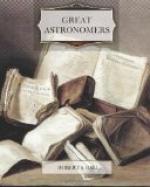At the present day, astronomers of the great national observatories are assiduously engaged in the determination of the places of the stars. A knowledge of the exact positions of these bodies is indeed of the most fundamental importance, not alone for the purposes of scientific astronomy, but also for navigation and for extensive operations of surveying in which accuracy is desired. The fact that Halley determined to concentrate himself on this work shows clearly the scientific acumen of the young astronomer.
Halley, however, found that Hevelius, at Dantzig, and Flamsteed, the Astronomer Royal at Greenwich, were both engaged on work of this character. He accordingly determined to direct his energies in a way that he thought would be more useful to science. He resigned to the two astronomers whom I have named the investigation of the stars in the northern hemisphere, and he sought for himself a field hitherto almost entirely unworked. He determined to go to the southern hemisphere, there to measure and survey those stars which were invisible in Europe, so that his work should supplement the labours of the northern astronomers, and that the joint result of his labours and of theirs might be a complete survey of the most important stars on the surface of the heavens.
In these days, after so many ardent students everywhere have devoted themselves to the study of Nature, it seems difficult for a beginner to find a virgin territory in which to commence his explorations. Halley may, however, be said to have enjoyed the privilege of commencing to work in a magnificent region, the contents of which were previously almost entirely unknown. Indeed none of the stars which were so situated as to have been invisible from Tycho Brahe’s observatory at Uraniborg, in Denmark, could be said to have been properly observed. There was, no doubt, a rumour that a Dutchman had observed southern stars from the island of Sumatra, and certain stars were indicated in the southern heavens on a celestial globe. On examination, however, Halley found that no reliance could be placed on the results which had been obtained, so that practically the field before him may be said to have been unworked.
At the age of twenty, without having even waited to take that degree at the university which the authorities would have been glad to confer on so promising an undergraduate, this ardent student of Nature sought his father’s permission to go to the southern hemisphere for the purpose of studying the stars which lie around the southern pole. His father possessed the necessary means, and he had likewise the sagacity to encourage the young astronomer. He was indeed most anxious to make every thing as easy as possible for so hopeful a son. He provided him with an allowance of 300 pounds a year, which was regarded as a very munificent provision in those days. Halley was also furnished with letters of recommendation from King Charles II., as well as from the directors of the East India Company. He accordingly set sail with his instruments in the year 1676, in one of the East India Company’s ships, for the island of St. Helena, which he had selected as the scene of his labours.




